Week 7: Reading
Soil Arthropods
By Andrew R. Moldenke, Oregon State University
THE LIVING SOIL: ARTHROPODS

Many bugs, known as arthropods, make their home in the soil. They get their name from their jointed (arthros) legs (podos). Arthropods are invertebrates, that is, they have no backbone, and rely instead on an external covering called an exoskeleton (figure 7-1).
Arthropods range in size from microscopic to several inches in length. They include insects, such as springtails, beetles, and ants; crustaceans such as sowbugs; arachnids such as spiders and mites; myriapods, such as centipedes and millipedes; and scorpions.
Nearly every soil is home to many different arthropod species. Certain row-crop soils contain several dozen species of arthropods in a square mile. Several thousand different species may live in a square mile of forest soil.
Arthropods can be grouped as shredders, predators, herbivores, and fungal-feeders, based on their functions in soil. Most soil-dwelling arthropods eat fungi, worms, or other arthropods. Root-feeders and dead-plant shredders are less abundant. As they feed, arthropods aerate and mix the soil, regulate the population size of other soil organisms, and shred organic material.
Shredders
Many large arthropods frequently seen on the soil surface are shredders. Shredders chew up dead plant matter as they eat bacteria and fungi on the surface of the plant matter. The most abundant shredders are millipedes and sowbugs, as well as termites, certain mites, and roaches. In agricultural soils, shredders can become pests by feeding on live roots if sufficient dead plant material is not present (figure 7-2 & figure 7-3).

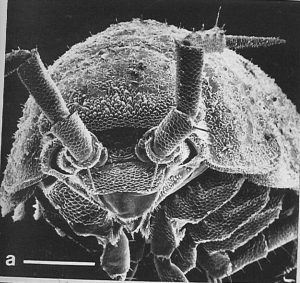
Predators
Predators and micropredators can be either generalists, feeding on many different prey types, or specialists, hunting only a single prey type. Predators include centipedes, spiders, ground-beetles, scorpions, skunk-spiders, pseudoscorpions, ants, and some mites. Many predators eat crop pests, and some, such as beetles and parasitic wasps, have been developed for use as commercial biocontrols (figure 7-4, figure 7-5, figure 7-6, figure 7-7, figure 7-8, figure 7-9, & figure 7-10).
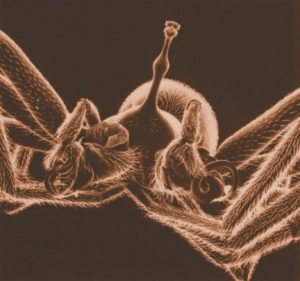
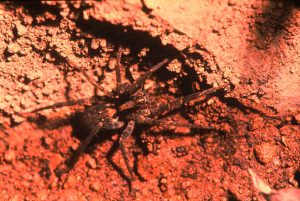




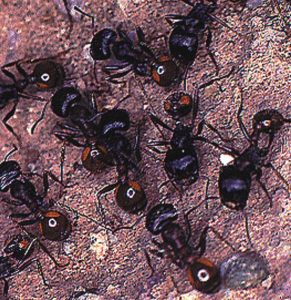
Herbivores
Numerous root-feeding insects, such as cicadas, mole-crickets, and anthomyiid flies (root-maggots), live part of all of their life in the soil. Some herbivores, including rootworms and symphylans, can be crop pests where they occur in large numbers, feeding on roots or other plant parts (figure 7-11).

Fungal Feeders
Arthropods that graze on fungi (and to some extent bacteria) include most springtails, some mites, and silverfish. They scrape and consume bacteria and fungi off root surfaces. A large fraction of the nutrients available to plants is a result of microbial-grazing and nutrient release by fauna (figure 7-12 & figure 7-13).

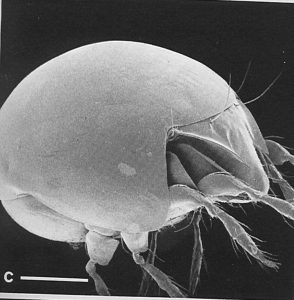
What Do Arthropods Do?
Although the plant feeders can become pests, most arthropods perform beneficial functions in the soil-plant system.
Shred organic material.
Arthropods increase the surface area accessible to microbial attack by shredding dead plant residue and burrowing into coarse woody debris. Without shredders, a bacterium in leaf litter would be like a person in a pantry without a can-opener – eating would be a very slow process. The shredders act like can-openers and greatly increase the rate of decomposition. Arthropods ingest decaying plant material to eat the bacteria and fungi on the surface of the organic material.
Stimulate microbial activity.
As arthropods graze on bacteria and fungi, they stimulate the growth of mycorrhizae and other fungi, and the decomposition of organic matter. If grazer populations get too dense the opposite effect can occur – populations of bacteria and fungi will decline. Predatory arthropods are important to keep grazer populations under control and to prevent them from over-grazing microbes.
Mix microbes with their food.
From a bacterium’s point-of-view, just a fraction of a millimeter is infinitely far away. Bacteria have limited mobility in soil and a competitor is likely to be closer to a nutrient treasure. Arthropods help out by distributing nutrients through the soil, and by carrying bacteria on their exoskeleton and through their digestive system. By more thoroughly mixing microbes with their food, arthropods enhance organic matter decomposition.
Mineralize plant nutrients.
As they graze, arthropods mineralize some of the nutrients in bacteria and fungi, and excrete nutrients in plant-available forms.
Enhance soil aggregation.
In most forested and grassland soils, every particle in the upper several inches of soil has been through the gut of numerous soil fauna. Each time soil passes through another arthropod or earthworm, it is thoroughly mixed with organic matter and mucus and deposited as fecal pellets. Fecal pellets are a highly concentrated nutrient resource, and are a mixture of the organic and inorganic substances required for growth of bacteria and fungi. In many soils, aggregates between 1/10,000 and 1/10 of an inch (0.0025mm and 2.5mm) are actually fecal pellets.
Burrow.
Relatively few arthropod species burrow through the soil. Yet, within any soil community, burrowing arthropods and earthworms exert an enormous influence on the composition of the total fauna by shaping habitat. Burrowing changes the physical properties of soil, including porosity, water-infiltration rate, and bulk density.
Stimulate the succession of species.
A dizzying array of natural bio-organic chemicals permeates the soil. Complete digestion of these chemicals requires a series of many types of bacteria, fungi, and other organisms with different enzymes. At any time, only a small subset of species is metabolically active – only those capable of using the resources currently available. Soil arthropods consume the dominant organisms and permit other species to move in and take their place, thus facilitating the progressive breakdown of soil organic matter.
Control pests.
Some arthropods can be damaging to crop yields, but many others that are present in all soils eat or compete with various root- and foliage-feeders. Some (the specialists) feed on only a single type of prey species. Other arthropods (the generalists), such as many species of centipedes, spiders, ground-beetles, rove-beetles, and gamasid mites, feed on a broad range of prey. Where a healthy population of generalist predators is present, they will be available to deal with a variety of pest outbreaks. A population of predators can only be maintained between pest outbreaks if there is a constant source of non-pest prey to eat. That is, there must be a healthy and diverse food web.
A fundamental dilemma in pest control is that tillage and insecticide application have enormous effects on non- target species in the food web. Intense land use (especially monoculture, tillage, and pesticides) depletes soil diversity. As total soil diversity declines, predator populations drop sharply and the possibility for subsequent pest outbreaks increases.
Where Do Arthropods Live?
The abundance and diversity of soil fauna diminishes significantly with soil depth. The great majority of all soil species are confined to the top three inches. Most of these creatures have limited mobility, and are probably capable of “cryptobiosis,” a state of “suspended animation” that helps them survive extremes of temperature, wetness, or dryness that would otherwise be lethal.
As a general rule, larger species are active on the soil surface, seeking temporary refuge under vegetation, plant residue, wood, or rocks. Many of these arthropods commute daily to forage within herbaceous vegetation above, or even high in the canopy of trees. (For instance, one of these tree-climbers is the caterpillar-searcher used by foresters to control gypsy moth). Some large species capable of true burrowing live within the deeper layers of the soil.
Below about two inches in the soil, fauna are generally small – 1/250 to 1/10 of an inch. (Twenty-five of the smallest of these would fit in a period on this page.) These species are usually blind and lack prominent coloration. They are capable of squeezing through minute pore spaces and along root channels. Sub-surface soil dwellers are associated primarily with the rhizosphere (the soil volume immediately adjacent to roots).
Abundance of Arthropods
A single square yard of soil will contain 500 to 200,000 individual arthropods, depending upon the soil type, plant community, and management system. Despite these large numbers, the biomass of arthropods in soil is far less than that of protozoa and nematodes.
In most environments, the most abundant soil dwellers are springtails and mites, though ants and termites predominate in certain situations, especially in desert and tropical soils. The largest number of arthropods are in natural plant communities with few earthworms (such as conifer forests). Natural communities with numerous earthworms (such as grassland soils) have the fewest arthropods. Earthworms out-compete arthropods, perhaps by excessively reworking their habitat or eating them incidentally. However, within pastures and farm lands arthropod numbers and diversity are generally thought to increase as earthworm populations rise. Burrowing earthworms probably create habitat space for arthropods in agricultural soils.
Bug Biography: Springtails
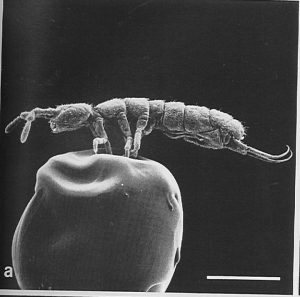
Springtails are the most abundant arthropods in many agricultural and rangeland soils (figure 7-14). Populations of tens of thousands per square yard are frequent. When foraging, springtails walk with 3 pairs of legs like most insects, and hold their tail tightly tucked under the belly. If attacked by a predator, body fluid rushes into the tail base, forcing the tail to slam down and catapult the springtail as much as a yard away. Springtails have been shown to be beneficial to crop plants by releasing nutrients and by feeding upon diseases caused by fungi.
Collembola Families: Photo Guide (figure 7-15)


